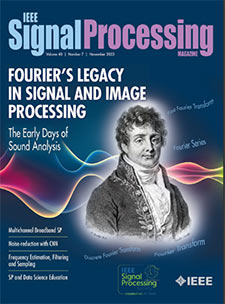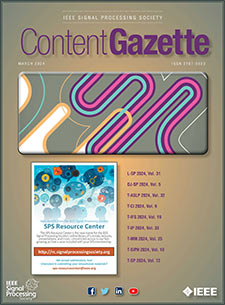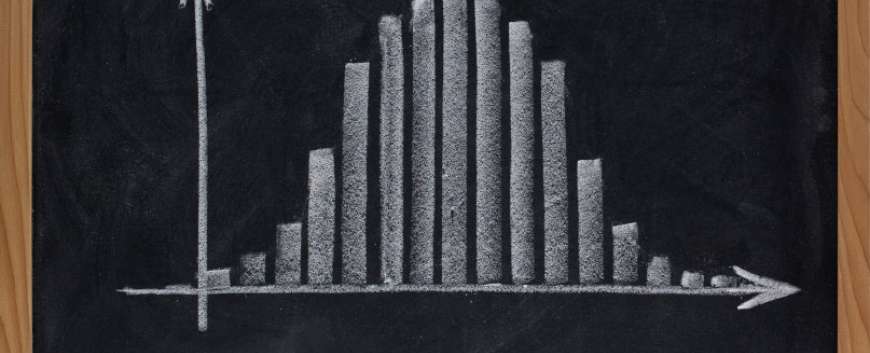- Our Story
- Publications & Resources
- Publications & Resources
- Publications
- IEEE Signal Processing Magazine
- IEEE Journal of Selected Topics in Signal Processing
- IEEE Signal Processing Letters
- IEEE/ACM Transactions on Audio Speech and Language Processing
- IEEE Transactions on Computational Imaging
- IEEE Transactions on Image Processing
- IEEE Transactions on Information Forensics and Security
- IEEE Transactions on Multimedia
- IEEE Transactions on Signal and Information Processing over Networks
- IEEE Transactions on Signal Processing
- IEEE TCI
- IEEE TSIPN
- Data & Challenges
- Submit Manuscript
- Guidelines
- Information for Authors
- Special Issue Deadlines
- Overview Articles
- Top Accessed Articles
- SPS Newsletter
- SigPort
- SPS Resource Center
- Publications Feedback
- Publications FAQ
- Blog
- News
- Dataset Papers
- Conferences & Events
- Community & Involvement
- Professional Development
- For Volunteers
- Information for Authors-OJSP
-
Home
Conferences Events IEEE JSTSP Article IEEE Signal Processing Magazine IEEE TIFS Article IEEE TMM Article IEEE TSP Article Jobs in Signal Processing Lectures Machine Learning Seasonal Schools Signal Processing News SPM Article SPS Distinguished Lectures SPS Newsletter Article SPS Webinar SPS Webinars SPS Webinar Series Webinar webinars
-
Our Story
What is Signal Processing?

The technology we use, and even rely on, in our everyday lives –computers, radios, video, cell phones – is enabled by signal processing. Learn More » -
Publications & Resources
-
SPS Resources
- Signal Processing Magazine The premier publication of the society.
- SPS Newsletter Monthly updates in Signal Processing
- SPS Resource Center Online library of tutorials, lectures, and presentations.
- SigPort Online repository for reports, papers, and more.
- SPS Feed The latest news, events, and more from the world of Signal Processing.
-
SPS Resources
-
Conferences & Events
-
Community & Involvement
-
Membership
- Join SPS The IEEE Signal Processing Magazine, Conference, Discounts, Awards, Collaborations, and more!
- Chapter Locator Find your local chapter and connect with fellow industry professionals, academics and students
- Women in Signal Processing Networking and engagement opportunities for women across signal processing disciplines
- Students Scholarships, conference discounts, travel grants, SP Cup, VIP Cup, 5-MICC
- Young Professionals Career development opportunities, networking
- Get Involved
-
Technical Committees
- Applied Signal Processing Systems
- Audio and Acoustic Signal Processing
- Bio Imaging and Signal Processing
- Computational Imaging
- Image Video and Multidimensional Signal Processing
- Information Forensics and Security
- Machine Learning for Signal Processing
- Multimedia Signal Processing
- Sensor Array and Multichannel
- Signal Processing for Communication and Networking
- Signal Processing Theory and Methods
- Speech and Language Processing
- Technical Working Groups
- More TC Resources
-
Membership
-
Professional Development
-
Professional Development
- Mentoring Experiences for Underrepresented Young Researchers (ME-UYR)
- Micro Mentoring Experience Program (MiME)
- Distinguished Lecturer Program
- Distinguished Lecturers
- Distinguished Lecturer Nominations
- Past Lecturers
- Distinguished Industry Speaker Program
- Distinguished Industry Speakers
- Distinguished Industry Speaker Nominations
- Industry Resources
- IEEE Training Materials
- Jobs in Signal Processing: IEEE Job Site
-
Career Resources
- SPS Education Program Educational content in signal processing and related fields.
- Distinguished Lecturer Program Chapters have access to educators and authors in the fields of Signal Processing
- PROGRESS Initiative Promoting diversity in the field of signal processing.
- Job Opportunities Signal Processing and Technical Committee specific job opportunities
- Job Submission Form Employers may submit opportunities in the area of Signal Processing.
-
Professional Development
-
For Volunteers
-
For Board & Committee Members
- Board Agenda/Minutes* Agendas, minutes and supporting documentation for Board and Committee Members
- SPS Directory* Directory of volunteers, society and division directory for Board and Committee Members.
- Membership Development Reports* Insight into the Society’s month-over-month and year-over-year growths and declines for Board and Committee Members
-
For Board & Committee Members
Popular Pages
Today's:
- Submit a Manuscript
- Information for Authors
- (ICASSP 2024) 2024 IEEE International Conference on Acoustics, Speech and Signal Processing
- Signal Processing Cup
- IEEE Transactions on Multimedia
- Membership
- (ICASSP 2025) 2025 IEEE International Conference on Acoustics, Speech and Signal Processing
- IEEE/ACM Transactions on Audio Speech and Language Processing
- IEEE Transactions on Image Processing
- (MLSP 2024) 2024 IEEE International Workshop on Machine Learning for Signal Processing
- (SLT 2024) 2024 IEEE Spoken Language Technology Workshop
- Award Recipients
- IEEE Signal Processing Letters
- IEEE Transactions on Information Forensics and Security
- Signal Processing 101
All time:
- Information for Authors
- Submit a Manuscript
- IEEE Transactions on Image Processing
- 404 Page
- IEEE/ACM Transactions on Audio Speech and Language Processing
- IEEE Transactions on Information Forensics and Security
- IEEE Transactions on Multimedia
- IEEE Signal Processing Letters
- IEEE Transactions on Signal Processing
- Conferences & Events
- IEEE Journal of Selected Topics in Signal Processing
- Information for Authors-SPL
- Conference Call for Papers
- Signal Processing 101
- IEEE Signal Processing Magazine
Last viewed:
- SPS Scholarship Program
- (ICASSP 2025) 2025 IEEE International Conference on Acoustics, Speech and Signal Processing
- (DCC 2023) 2023 Data Compression Conference
- Governance Documents
- Information for Authors
- A Free Machine Learning Lecture Series on the SPS Resource Center!
- Top Accessed Articles
- Women in Signal Processing
- Membership
- Submit a Manuscript
- Publications & Resources
- (SPAWC 2024) 2024 IEEE 25th International Workshop on Signal Processing Advances in Wireless Communications
- (ICIP 2025) 2025 IEEE International Conference on Image Processing
- IEEE/ACM Transactions on Audio Speech and Language Processing
- IEEE Transactions on Multimedia
Igor Moáco Guerreiro, Federal University of Ceará, Brazil (2017)
You are here
Newsletter Menu
Newsletter Categories
Top Reasons to Join SPS Today!
1. IEEE Signal Processing Magazine
2. Signal Processing Digital Library*
3. Inside Signal Processing Newsletter
4. SPS Resource Center
5. Career advancement & recognition
6. Discounts on conferences and publications
7. Professional networking
8. Communities for students, young professionals, and women
9. Volunteer opportunities
10. Coming soon! PDH/CEU credits
Click here to learn more.
News and Resources for Members of the IEEE Signal Processing Society
Igor Moáco Guerreiro, Federal University of Ceará, Brazil (2017)
Igor Moáco Guerreiro, Federal University of Ceará, Brazil (2017), "Distributed optimization techniques for 4G and beyond", advisor: Charles Casimiro Cavalcante
In today’s and future wireless telecommunication systems, the use of multiple antenna elements on the transmitter side, and also on the receiver side, provides users a better experience in terms of data rate, coverage and energy efficiency. In the fourth generation of such systems, precoding emerged as a relevant problem to be optimally solved so that network capacity can be increased by exploiting the characteristics of the channel. In this case, transmitters are equipped with few antenna elements, say up to eight, which means there are a few tens of precoding matrices, assuming a discrete codebook, to be coordinated per transmitter. As the number of antenna elements increases at communication nodes, conditions to keep in providing good experience for users become challenging. That’s one of the challenges of the fifth generation. Every transmitter must deal with narrow beams when a massive number of antenna elements is adopted. The hard part, regarding the narrowness of beams, is to keep the spatial alignment between transmitter and receiver. Any misalignment makes the received signal quality drop significantly so that users no longer experience good coverage. In particular, to provide initial access to unsynchronized devices, transmitters need to find the best beams to send synchronization signals consuming as little power as possible without any knowledge on unsynchronized devices’ channel states.
This thesis thus addresses both precoding and beam finding as parameter coordination problems. The goal is to provide methods to solve them in a distributed manner. For this purpose, two types of iterative algorithms are presented for both. The first and simplest method is the greedy solution in which each communication node in the network acts selfishly. The second method and the focus of this work is based on a message-passing algorithm, namely min-sum algorithm, in factor graphs. The precoding problem is modeled as a discrete optimization one whose discrete variables comprise precoding matrix indexes. As for beam finding, a beam sweep procedure is adopted and the total consumed power over the network is optimized. Numerical results show that the graph-based solution outperforms the baseline/greedy one in terms of the following performance metrics: a) system capacity for the precoding problem, and b) power consumption for the beam finding one. Although message-passing demands more signaling load and more iterations to converge compared to baseline method, it usually provides a near-optimal solution in a more efficient way than the centralized solution.
Open Calls
Society News
Initiatives & Trends
TC News
Member Highlights
PhD Theses
Chapter & DL News
Conference News
SPS on Twitter
- DEADLINE EXTENDED: The 2023 IEEE International Workshop on Machine Learning for Signal Processing is now accepting… https://t.co/NLH2u19a3y
- ONE MONTH OUT! We are celebrating the inaugural SPS Day on 2 June, honoring the date the Society was established in… https://t.co/V6Z3wKGK1O
- The new SPS Scholarship Program welcomes applications from students interested in pursuing signal processing educat… https://t.co/0aYPMDSWDj
- CALL FOR PAPERS: The IEEE Journal of Selected Topics in Signal Processing is now seeking submissions for a Special… https://t.co/NPCGrSjQbh
- Test your knowledge of signal processing history with our April trivia! Our 75th anniversary celebration continues:… https://t.co/4xal7voFER
Home | Sitemap | Contact | Accessibility | Nondiscrimination Policy | IEEE Ethics Reporting | IEEE Privacy Policy | Terms | Feedback
© Copyright 2024 IEEE – All rights reserved. Use of this website signifies your agreement to the IEEE Terms and Conditions.
A not-for-profit organization, IEEE is the world's largest technical professional organization dedicated to advancing technology for the benefit of humanity.









